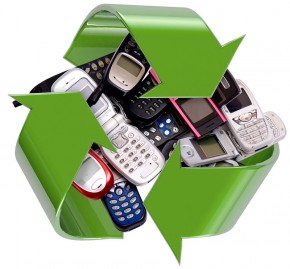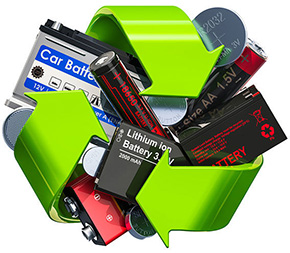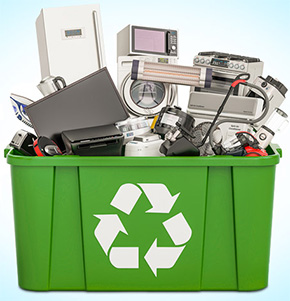Sahastradhara Road, Near IT Park, Dehradun (UK) - 248001
Recycling Solution
Dev Bhoomi Recycling’s core strength lies in its innovation and technological prowess that gives an unprecedented edge to our recycling operations. Our recycling technology aims to take today’s waste and turn it into conflict-free, sustainable resources for tomorrow.
End of life electronics are recycled at Dev Bhoomi Recycling’s state-of-the-art recycling plant, using disruptive technology, to extract reusable materials. Developed in house, at Dev Bhoomi Recycling’s R&D facility, our recycling technology ensures that e-Waste is processed in an environmentally friendly manner, with high efficiency and lowered carbon footprint, at a fraction of the costs involved with setting multibillion dollar smelting facilities.
With the right technology, recycling can offer a potent resource for our planet, transforming millions of tons of e-Waste into reusable material. Dev Bhoomi Recycling’s high-tech recycling facility extractsvaluable resources like precious metals and semi-precious metals along with rare earth elements and other reusable materials and minerals, from electronic waste, efficiently in a sustainable and environmentally responsible manner. Taking into consideration our depleting natural resources, this urban mining approach offers quite a few benefits – it provides a substantial secondary resource, which is highly suitable for direct use, while also ensuring that the environment is kept free from harmful toxins in e-Waste. This results in increased energy efficiency and lowers demand for mining of new materials.
Powered with this sustainable recycling technology, Dev Bhoomi Recycling offers an easy and hassle free solution for organizations to manage their electronic assets and e-Waste more efficiently and effectively, while also safeguarding them from legal and environmental risks associated with e-waste disposal.
 Mobile phone recycling at Dev Bhoomi Recycling begins with the unloading ofthe units at Dev Bhoomi Recycling’s recycling facility, where they are scanned and updated in the system. Once the units have been unloaded, they are separated for recycling and refurbishing. Units destined for refurbishing are sent to Dev Bhoomi Recycling’s refurbishing operations section, while the others are sent to the recycling section. Devices sent for refurbishing are further tested, and the ones with heavy wear and tear are sent back to the recycling section. Mobiles destined for recycling are first manually dismantled, where the lithium ion battery, the flat panel/LCD, PCBs and plastic are separated. All these separated components are then recycled in different sections, with the batteries going to the battery recycling section, the display going to the LCD recycling section, the printed circuit boards going to the PCB recycling section and the plastic going to the plastic recycling operation. After processing the recovered materials can be used again in a number of different industries, such as electronics, plating, jewellery, automotive and art foundries.
Mobile phone recycling at Dev Bhoomi Recycling begins with the unloading ofthe units at Dev Bhoomi Recycling’s recycling facility, where they are scanned and updated in the system. Once the units have been unloaded, they are separated for recycling and refurbishing. Units destined for refurbishing are sent to Dev Bhoomi Recycling’s refurbishing operations section, while the others are sent to the recycling section. Devices sent for refurbishing are further tested, and the ones with heavy wear and tear are sent back to the recycling section. Mobiles destined for recycling are first manually dismantled, where the lithium ion battery, the flat panel/LCD, PCBs and plastic are separated. All these separated components are then recycled in different sections, with the batteries going to the battery recycling section, the display going to the LCD recycling section, the printed circuit boards going to the PCB recycling section and the plastic going to the plastic recycling operation. After processing the recovered materials can be used again in a number of different industries, such as electronics, plating, jewellery, automotive and art foundries.
 CRT Recycling: Cathode Ray Tubes (CRT) contain significant amounts of lead and glass which can be recovered and reused. As a first step, CRT display units are unloaded at Dev Bhoomi Recycling’s recycling facility and scanned by barcode reader. The scan details are then uploaded on the system. Next the CRT cutter system separates the glass panel and glass and fluorescent powder (lead & phosphor) is collected. The process involves glass cutting, heating through metal band & air blow. Next, they are sent to the vacuum chamber, following which the lead and phosphor are collected in bags, while the glass is collected in folders. For processing one CRT unit the machine takes roughly 90 seconds. Circuit boards, chips and other parts are recycled separately.
CRT Recycling: Cathode Ray Tubes (CRT) contain significant amounts of lead and glass which can be recovered and reused. As a first step, CRT display units are unloaded at Dev Bhoomi Recycling’s recycling facility and scanned by barcode reader. The scan details are then uploaded on the system. Next the CRT cutter system separates the glass panel and glass and fluorescent powder (lead & phosphor) is collected. The process involves glass cutting, heating through metal band & air blow. Next, they are sent to the vacuum chamber, following which the lead and phosphor are collected in bags, while the glass is collected in folders. For processing one CRT unit the machine takes roughly 90 seconds. Circuit boards, chips and other parts are recycled separately.
Flat Panel Display Unit Recycling: Recycling of TFT and flat panel display units begins with the segregation of the device, following which the unit is dismantled. During dismantling components like wires, cables and PCBs are segregated and sent for recycling separately. The display unit then goes through the mechanical shredder, where it is processed. Next the unit is passed through the Magnetic Separator, where ferrous metals are automatically removed. The next stage involves the separation and collection of non-ferrous metals like aluminium, copper etc. in the Eddy Current Separator. The separated components are then processed individually. The plastic components left behind after the eddy current separator stage is segregated and recycled. The ferrous components collected from the magnetic separator are processed to iron, while the copper and aluminium collected from the eddy current separator are smelted and go through electro-refining, where metals are refined to 99.9% purity.
 Recycling of lead acid batteries at Dev Bhoomi Recycling’s facility begins with battery breaking. The lead acid batteries are broken down to recover lead. The top portion of the battery is removed and the acid is drained out for neutralization. The top portion is transported to a hammer mill, where the plastic is shredded and the lead posts that are fixed on the top are released. The remaining portion of the case along with its contents and the battery plates are passed through a trammel, which extracts the plates. The plastic is then separated by passing through a mill, and extracted via clarifiers and stockpiled for furnace feed.
Recycling of lead acid batteries at Dev Bhoomi Recycling’s facility begins with battery breaking. The lead acid batteries are broken down to recover lead. The top portion of the battery is removed and the acid is drained out for neutralization. The top portion is transported to a hammer mill, where the plastic is shredded and the lead posts that are fixed on the top are released. The remaining portion of the case along with its contents and the battery plates are passed through a trammel, which extracts the plates. The plastic is then separated by passing through a mill, and extracted via clarifiers and stockpiled for furnace feed.
The next step involves furnace smelting. There are three main constituents that make up the charge for lead smelting – lead bearing materials, reducing agents and oxygen. The reducing agents used include coke and iron, along with sodium carbonate for facilitating slag formation. All these materials are charged into the furnace during one operation. The rotary action of the furnace facilitates mixing. The slag is then tapped, cooled, broken, disposed and the recovered lead along with its impurities is sent to the refinery for specification.
When the bullion lead reaches the refinery, it is first cleaned of molten oxides and sulphides by lowering the temperature of the lead, which decreases the solubility of the impurities. Once the oxides and sulphides have been removed, the metal is treated for alloy specification to remove metals like copper, tin, antimony etc. After the metal has been purified, it is cast into lead ingots and can be reused.
When the bullion lead reaches the refinery, it is first cleaned of molten oxides and sulphides by lowering the temperature of the lead, which decreases the solubility of the impurities. Once the oxides and sulphides have been removed, the metal is treated for alloy specification to remove metals like copper, tin, antimony etc. After the metal has been purified, it is cast into lead ingots and can be reused.
Apart from lead-acid batteries, Dev Bhoomi Recycling recycles all other types of batteries classified as e-waste by the EPA.
 Electronic printed circuit boards are complex assemblies that include numerous materials, and these materials require large quantities of energy and other materials to manufacture. They also include significant quantities of metals such as lead, copper and nickel. While some of these are toxic in nature, all of them are valuable resources.
Electronic printed circuit boards are complex assemblies that include numerous materials, and these materials require large quantities of energy and other materials to manufacture. They also include significant quantities of metals such as lead, copper and nickel. While some of these are toxic in nature, all of them are valuable resources.
The recycling of electronic printed circuit boards begins with the circuit boards being passed through the Component Removal Machine. This machine automatically separates all the assembled components on the circuit board. It is then pulverized and shredded. The output from these processing stages is the blank board and its components. The blank board primarily contains copper, which is smelted and electro-refined to obtain 99.9% pure copper bars. The separated components are classified as heavy and light chips and include transistors, diodes, connectors and miscellaneous parts such as capacitors and heat sinks among others. Magnetic separation is carried out to separate ferrous metals as well as some of the copper alloys. This is followed by eddy current separation to separate non-ferrous metals. All of these components are smelted to obtain pure metals. Plastic components are separated through density based separation.
 I.T. goods include various electronics ranging from desktops, laptops and servers to printers, scanners and copiers. Once these electronics items are received at Dev Bhoomi Recycling’s processing plant they are checked to determine whether they should be recycled or refurbished. After segregating the units suitable for refurbishing they are forwarded to Dev Bhoomi Recycling’s refurbishing section, while the remaining units are sent for recycling.The electronics sent for recycling are first segregated and then dismantled. During dismantling, the wire and cable components in the devices are taken out and sent for recycling. Next, the components like LCD, PCB, RAM, SMPS and plastic parts are segregated and recycled separately. The remaining components are sent for processing to the mechanical shredder, following which they are sent to the magnetic separator. The magnetic separator separates the ferrous components from which iron is extracted. The remainder is then passed through the Eddy Current separator, which separates non-ferrous metals like copper and aluminium. These metals are then smelted and purified. The plastic components are forwarded for plastic recycling at Dev Bhoomi Recycling’s plant.
I.T. goods include various electronics ranging from desktops, laptops and servers to printers, scanners and copiers. Once these electronics items are received at Dev Bhoomi Recycling’s processing plant they are checked to determine whether they should be recycled or refurbished. After segregating the units suitable for refurbishing they are forwarded to Dev Bhoomi Recycling’s refurbishing section, while the remaining units are sent for recycling.The electronics sent for recycling are first segregated and then dismantled. During dismantling, the wire and cable components in the devices are taken out and sent for recycling. Next, the components like LCD, PCB, RAM, SMPS and plastic parts are segregated and recycled separately. The remaining components are sent for processing to the mechanical shredder, following which they are sent to the magnetic separator. The magnetic separator separates the ferrous components from which iron is extracted. The remainder is then passed through the Eddy Current separator, which separates non-ferrous metals like copper and aluminium. These metals are then smelted and purified. The plastic components are forwarded for plastic recycling at Dev Bhoomi Recycling’s plant.
© Dev Bhoomi Recycling Pvt. Ltd. 2020 | Powered by ITArchs.com
